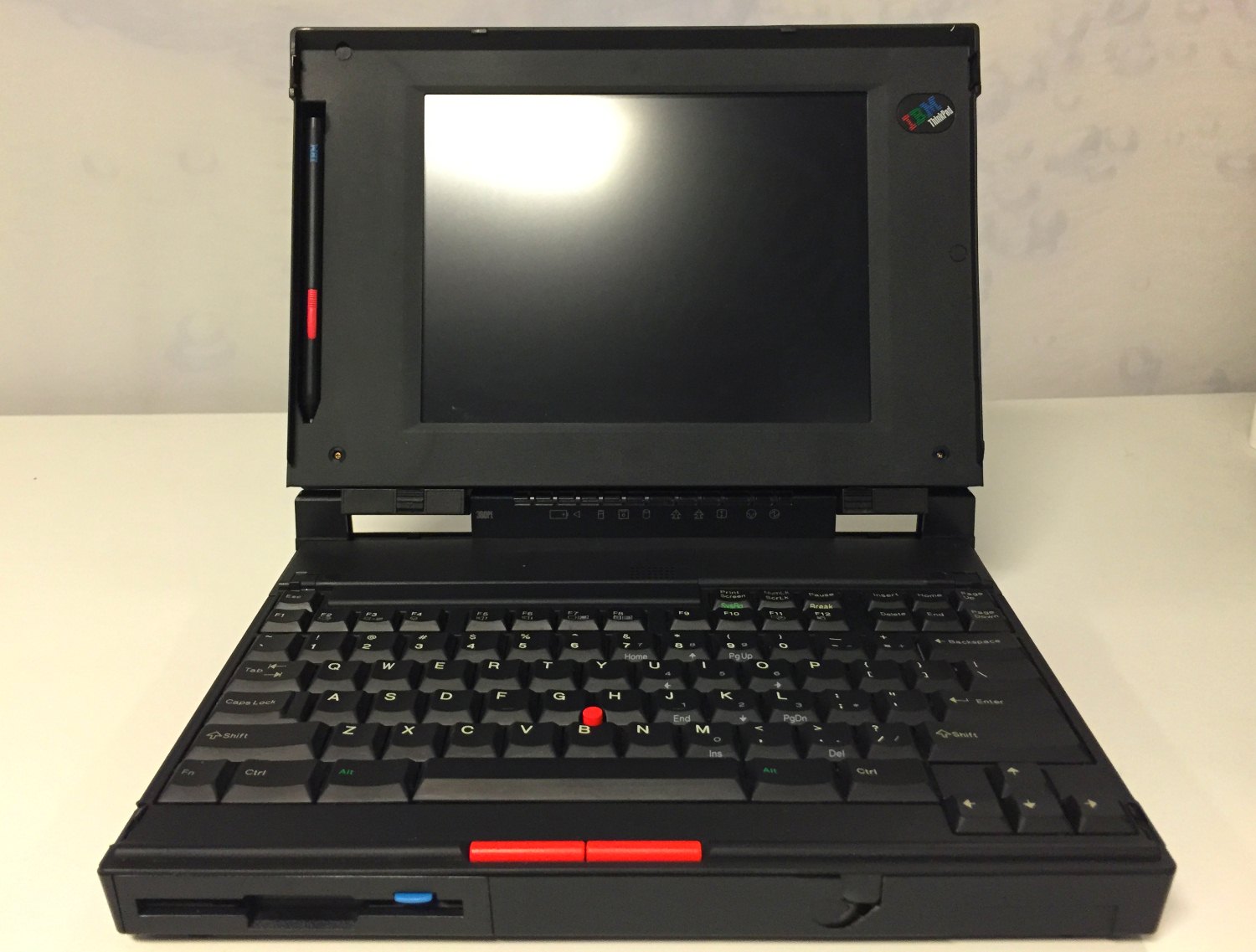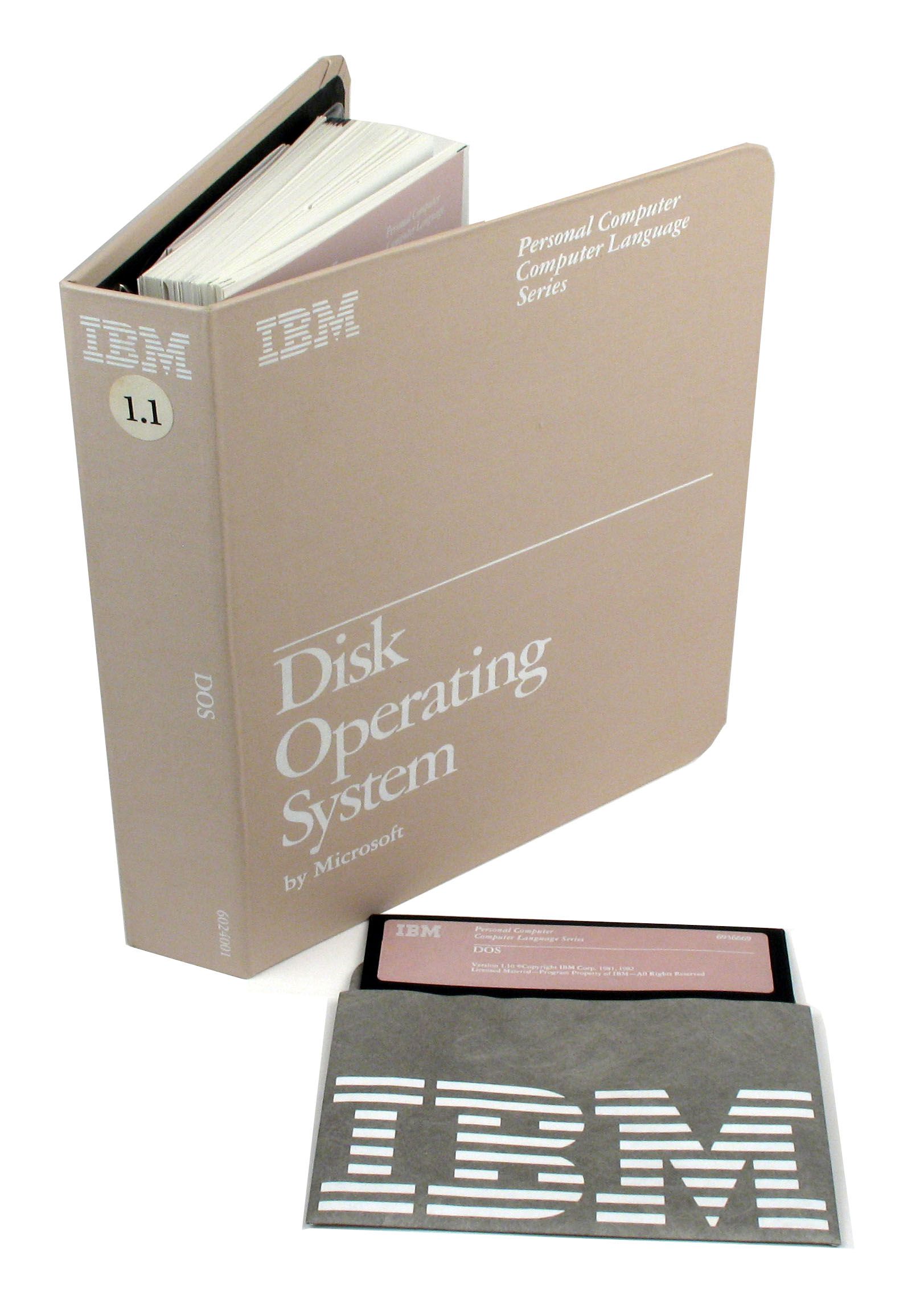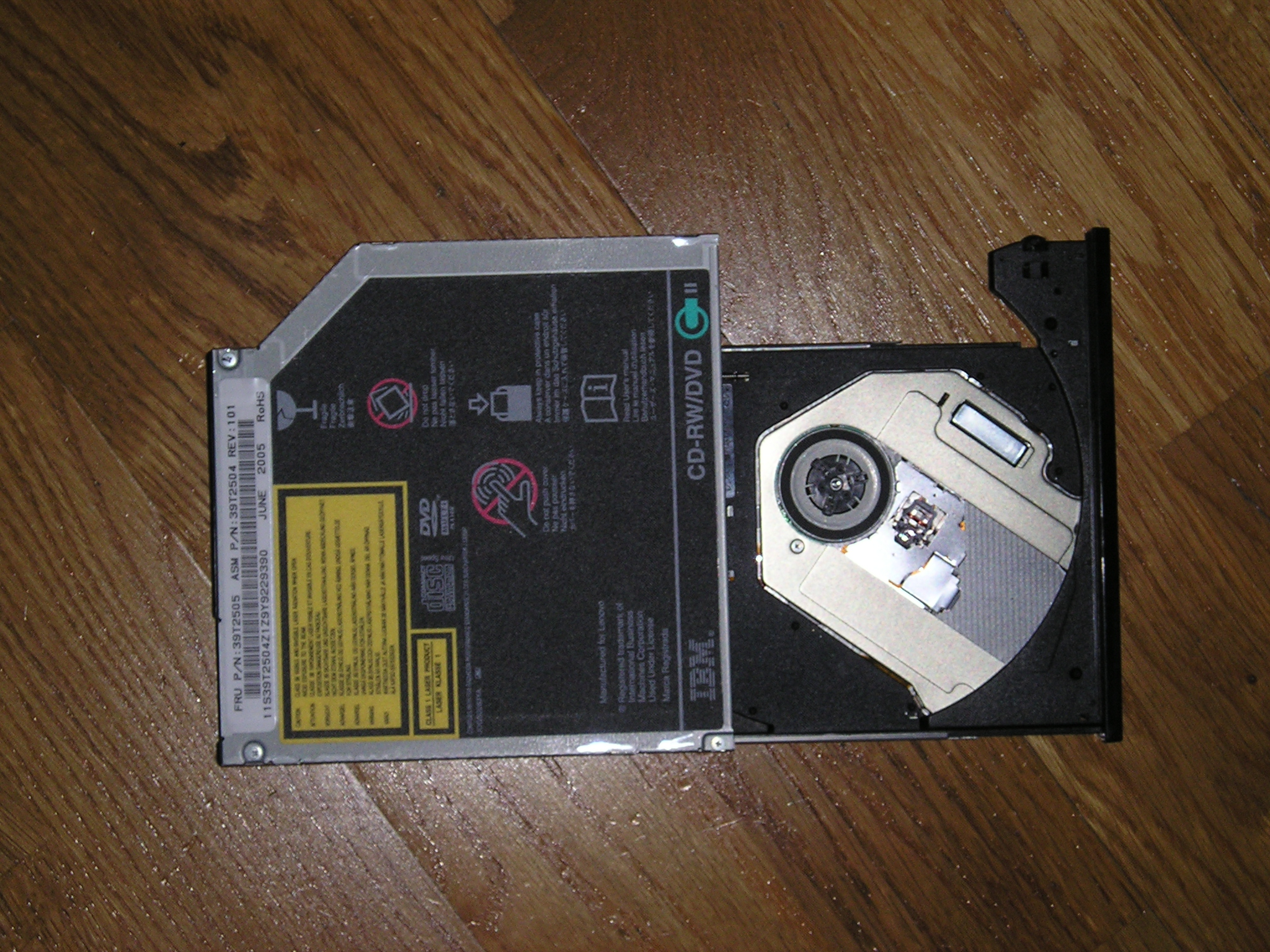|
IBM ThinkPad 360
The IBM ThinkPad 360 series was a notebook computer series introduced in 1994 by IBM as part of their ThinkPad laptop series. It was succeeded in late 1995 by the IBM ThinkPad 365 series. History On October 17th, 1994, the ThinkPad 360 CE and CSE were released. Both had a Intel 486DX-2 50 MHz processor, 4 MB of memory, a 1.44 MB floppy disk drive, and a 250, 340, 540, or 810 MB hard disk drive with PC DOS 6.0/Windows 3.1 and various included software. Both units came with a Nickel-Metal Hydride (NiMH) battery pack that could last 2.9 hours in a CSE and 3.2 hours in a CE, while only taking 1.5 hours to charge. Both the CE and CSE were mainly the same in terms of specifications, with the only notable difference of a 9.5in 640x480 DSTN screen for the CSE and a 8.4in 640x480 TFT screen for the CE. It cost between $2,649 and $4,199 for a unit depending on the configuration. Many of the models in the 360 series were discontinued by IBM on december 21, 1995. This included the CS, C, P ... [...More Info...] [...Related Items...] OR: [Wikipedia] [Google] [Baidu] |
IBM PC DOS
IBM PC DOS, an acronym for IBM Personal Computer Disk Operating System, is a discontinued disk operating system for IBM PC compatibles. It was manufactured and sold by IBM from the early 1980s into the 2000s. Developed by Microsoft, it was also sold by that company as MS-DOS. Both operating systems were identical or almost identical until 1993, when IBM began selling PC DOS 6.1 with new features. The collective shorthand for PC DOS and MS-DOS was DOS, which is also the generic term for disk operating system, and is shared with dozens of disk operating systems called DOS. History The IBM task force assembled to develop the IBM PC decided that critical components of the machine, including the operating system, would come from outside vendors. This radical break from company tradition of in-house development was one of the key decisions that made the IBM PC an industry standard. Microsoft, founded five years earlier by Bill Gates, was eventually selected for the operating system. ... [...More Info...] [...Related Items...] OR: [Wikipedia] [Google] [Baidu] |
Intel
Intel Corporation is an American multinational corporation and technology company headquartered in Santa Clara, California. It is the world's largest semiconductor chip manufacturer by revenue, and is one of the developers of the x86 series of instruction sets, the instruction sets found in most personal computers (PCs). Incorporated in Delaware, Intel ranked No. 45 in the 2020 ''Fortune'' 500 list of the largest United States corporations by total revenue for nearly a decade, from 2007 to 2016 fiscal years. Intel supplies microprocessors for computer system manufacturers such as Acer, Lenovo, HP, and Dell. Intel also manufactures motherboard chipsets, network interface controllers and integrated circuits, flash memory, graphics chips, embedded processors and other devices related to communications and computing. Intel (''int''egrated and ''el''ectronics) was founded on July 18, 1968, by semiconductor pioneers Gordon Moore (of Moore's law) and Robert Noyce ( ... [...More Info...] [...Related Items...] OR: [Wikipedia] [Google] [Baidu] |
IBM ThinkPad 350
The IBM Thinkpad 350 series was a notebook computer series introduced in 1993 by IBM as part of their Thinkpad laptop series. It was the successor to the IBM ThinkPad 300. With only 2 models ever made in the series, it was succeeded in 1994 by the IBM Thinkpad 360 series. History The 350 was announced in June 1993. The 125MB disk version started shipping in June 1993, the 250MB version started shipping in July. Features The 350 series shipped with IBM PC DOS 5.02 as the included operating system. Both models in the series came with an Intel 486SL running at 25 MHz, and a CT-65530 video controller with 1 MB of video memory. Both models also had a standard 4 MB of RAM that was on a proprietary IC DRAM Card. If a user wanted to upgrade the ram, the 350 ThinkPads supported an IC DRAM Card size up to 20 MB. Both in the series came with a 125 or 250 MB standard hard drive, and a non-removable 1.44 MB floppy drive. Both models also had a battery life up to 9 hours. In March 199 ... [...More Info...] [...Related Items...] OR: [Wikipedia] [Google] [Baidu] |
Floppy Disk Drive
A floppy disk or floppy diskette (casually referred to as a floppy, or a diskette) is an obsolescent type of disk storage composed of a thin and flexible disk of a magnetic storage medium in a square or nearly square plastic enclosure lined with a fabric that removes dust particles from the spinning disk. Floppy disks store digital data which can be read and written when the disk is inserted into a floppy disk drive (FDD) connected to or inside a computer or other device. The first floppy disks, invented and made by IBM, had a disk diameter of . Subsequently, the 5¼-inch and then the 3½-inch became a ubiquitous form of data storage and transfer into the first years of the 21st century. 3½-inch floppy disks can still be used with an external USB floppy disk drive. USB drives for 5¼-inch, 8-inch, and other-size floppy disks are rare to non-existent. Some individuals and organizations continue to use older equipment to read or transfer data from floppy disks. Floppy disks ... [...More Info...] [...Related Items...] OR: [Wikipedia] [Google] [Baidu] |
Dynamic Random-access Memory
Dynamic random-access memory (dynamic RAM or DRAM) is a type of random-access semiconductor memory that stores each bit of data in a memory cell, usually consisting of a tiny capacitor and a transistor, both typically based on metal-oxide-semiconductor (MOS) technology. While most DRAM memory cell designs use a capacitor and transistor, some only use two transistors. In the designs where a capacitor is used, the capacitor can either be charged or discharged; these two states are taken to represent the two values of a bit, conventionally called 0 and 1. The electric charge on the capacitors gradually leaks away; without intervention the data on the capacitor would soon be lost. To prevent this, DRAM requires an external ''memory refresh'' circuit which periodically rewrites the data in the capacitors, restoring them to their original charge. This refresh process is the defining characteristic of dynamic random-access memory, in contrast to static random-access memory (SRAM ... [...More Info...] [...Related Items...] OR: [Wikipedia] [Google] [Baidu] |
Cache (computing)
In computing, a cache ( ) is a hardware or software component that stores data so that future requests for that data can be served faster; the data stored in a cache might be the result of an earlier computation or a copy of data stored elsewhere. A ''cache hit'' occurs when the requested data can be found in a cache, while a ''cache miss'' occurs when it cannot. Cache hits are served by reading data from the cache, which is faster than recomputing a result or reading from a slower data store; thus, the more requests that can be served from the cache, the faster the system performs. To be cost-effective and to enable efficient use of data, caches must be relatively small. Nevertheless, caches have proven themselves in many areas of computing, because typical computer applications access data with a high degree of locality of reference. Such access patterns exhibit temporal locality, where data is requested that has been recently requested already, and spatial locality, where d ... [...More Info...] [...Related Items...] OR: [Wikipedia] [Google] [Baidu] |
ThinkPad 360PE Normal Mode
ThinkPad is a line of business-oriented laptop computers and tablets designed, developed and marketed by Lenovo, and formerly by IBM until 2005, when IBM's PC business was acquired by Lenovo. ThinkPads have a distinct black, boxy design language, inspired by a Japanese ''bento'' lunchbox, which originated in 1990 and is still used in some models. Most models also feature a red-colored trackpoint on the keyboard, which has become an iconic and distinctive design characteristic associated with the ThinkPad line. The ThinkPad line was first developed at the IBM Yamato Facility in Japan, and the first ThinkPads were released in October 1992. It has seen significant success in the business market. ThinkPad laptops have been used in outer space and for many years were the only laptops certified for use on the International Space Station. ThinkPads have also for several years been one of the preferred laptops used by the United Nations. History The ThinkPad was developed to com ... [...More Info...] [...Related Items...] OR: [Wikipedia] [Google] [Baidu] |
ThinkPad UltraBay
UltraBay is originally IBM's name for the swappable drive bay in the ThinkPad range of laptop computers. When the ThinkPad product line was sold to Lenovo, the concept and the name stayed. Furthermore, it is used in some of Lenovo's own IdeaPad Y Series laptops. Introduced with the ThinkPad 750 series in 1995, this technology has gone through redesigns with almost every new generation of ThinkPad, which may lead to confusion. The following table gives an overview of the different UltraBay types, in which models they occurred and which drives are available for them. Note that the optical drive bay in G series and R40e series ThinkPads is not an UltraBay in that the drives are fixed and not removable. It is however, mechanically, an UltraBay 2000-device without the surrounding "caddy". On the media side different UltraBays relate to the form factor of the drives they accept; Some machines can accept UltraBay devices up to 12.5 mm thick, whereas others are limited to devices ... [...More Info...] [...Related Items...] OR: [Wikipedia] [Google] [Baidu] |
Hard Disk Drive
A hard disk drive (HDD), hard disk, hard drive, or fixed disk is an electro-mechanical data storage device that stores and retrieves digital data using magnetic storage with one or more rigid rapidly rotating platters coated with magnetic material. The platters are paired with magnetic heads, usually arranged on a moving actuator arm, which read and write data to the platter surfaces. Data is accessed in a random-access manner, meaning that individual blocks of data can be stored and retrieved in any order. HDDs are a type of non-volatile storage, retaining stored data when powered off. Modern HDDs are typically in the form of a small rectangular box. Introduced by IBM in 1956, HDDs were the dominant secondary storage device for general-purpose computers beginning in the early 1960s. HDDs maintained this position into the modern era of servers and personal computers, though personal computing devices produced in large volume, like cell phones and tablets, rely on ... [...More Info...] [...Related Items...] OR: [Wikipedia] [Google] [Baidu] |
Operating System
An operating system (OS) is system software that manages computer hardware, software resources, and provides common services for computer programs. Time-sharing operating systems schedule tasks for efficient use of the system and may also include accounting software for cost allocation of processor time, mass storage, printing, and other resources. For hardware functions such as input and output and memory allocation, the operating system acts as an intermediary between programs and the computer hardware, although the application code is usually executed directly by the hardware and frequently makes system calls to an OS function or is interrupted by it. Operating systems are found on many devices that contain a computer from cellular phones and video game consoles to web servers and supercomputers. The dominant general-purpose personal computer operating system is Microsoft Windows with a market share of around 74.99%. macOS by Apple Inc. is in second place (14.84%), and ... [...More Info...] [...Related Items...] OR: [Wikipedia] [Google] [Baidu] |
Windows 3
Windows 3.x means either of, or all of the following versions of Microsoft Windows: * Windows 3.0 * Windows 3.1x Windows 3.1 is a major release of Microsoft Windows. It was released to manufacturing on April 6, 1992, as a successor to Windows 3.0. Like its predecessors, the Windows 3.1 series ran as a shell on top of MS-DOS. Codenamed Janus, Windows 3 ... Windows NT * Windows NT 3.x 3.x {{Short pages monitor ... [...More Info...] [...Related Items...] OR: [Wikipedia] [Google] [Baidu] |
Nickel–metal Hydride Battery
A nickel metal hydride battery (NiMH or Ni–MH) is a type of rechargeable battery. The chemical reaction at the positive electrode is similar to that of the Nickel–cadmium battery, nickel–cadmium cell (NiCd), with both using nickel oxide hydroxide (NiOOH). However, the negative electrodes use a hydrogen-absorbing alloy instead of cadmium. NiMH batteries can have two to three times the capacity of Nickel–cadmium battery, NiCd batteries of the same size, with significantly higher energy density, although much less than Lithium-ion battery, lithium-ion batteries. They are typically used as a substitute for similarly shaped non-rechargeable Alkaline battery, alkaline batteries, as they feature a slightly lower but generally compatible cell voltage, and are less prone to leaking. History Work on NiMH batteries began at the Battelle Memorial Institute, Battelle-Geneva Research Center following the technology's invention in 1967. It was based on sintering, sintered Ti2N ... [...More Info...] [...Related Items...] OR: [Wikipedia] [Google] [Baidu] |



.jpg)





